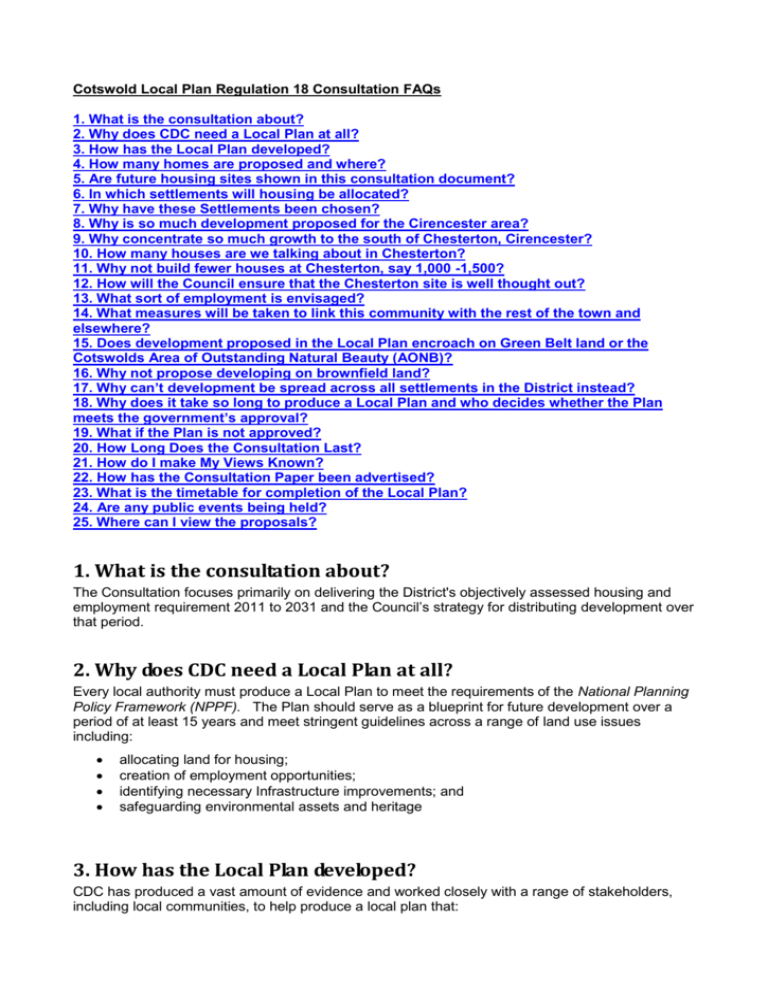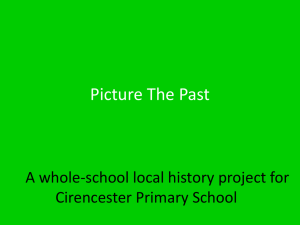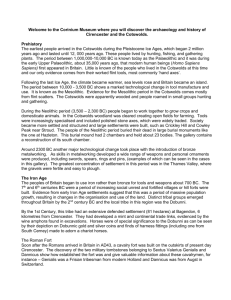18. Why does it take so long to produce a Local Plan and who
advertisement

Cotswold Local Plan Regulation 18 Consultation FAQs 1. What is the consultation about? 2. Why does CDC need a Local Plan at all? 3. How has the Local Plan developed? 4. How many homes are proposed and where? 5. Are future housing sites shown in this consultation document? 6. In which settlements will housing be allocated? 7. Why have these Settlements been chosen? 8. Why is so much development proposed for the Cirencester area? 9. Why concentrate so much growth to the south of Chesterton, Cirencester? 10. How many houses are we talking about in Chesterton? 11. Why not build fewer houses at Chesterton, say 1,000 -1,500? 12. How will the Council ensure that the Chesterton site is well thought out? 13. What sort of employment is envisaged? 14. What measures will be taken to link this community with the rest of the town and elsewhere? 15. Does development proposed in the Local Plan encroach on Green Belt land or the Cotswolds Area of Outstanding Natural Beauty (AONB)? 16. Why not propose developing on brownfield land? 17. Why can’t development be spread across all settlements in the District instead? 18. Why does it take so long to produce a Local Plan and who decides whether the Plan meets the government’s approval? 19. What if the Plan is not approved? 20. How Long Does the Consultation Last? 21. How do I make My Views Known? 22. How has the Consultation Paper been advertised? 23. What is the timetable for completion of the Local Plan? 24. Are any public events being held? 25. Where can I view the proposals? 1. What is the consultation about? The Consultation focuses primarily on delivering the District's objectively assessed housing and employment requirement 2011 to 2031 and the Council’s strategy for distributing development over that period. 2. Why does CDC need a Local Plan at all? Every local authority must produce a Local Plan to meet the requirements of the National Planning Policy Framework (NPPF). The Plan should serve as a blueprint for future development over a period of at least 15 years and meet stringent guidelines across a range of land use issues including: allocating land for housing; creation of employment opportunities; identifying necessary Infrastructure improvements; and safeguarding environmental assets and heritage 3. How has the Local Plan developed? CDC has produced a vast amount of evidence and worked closely with a range of stakeholders, including local communities, to help produce a local plan that: meets the future development needs of the area; is locally distinctive; takes account of the aspirations of local communities; and meets the requirements of national guidelines, notably the presumption in favour of sustainable development. We have sought views extensively through public consultations, workshops, drop-in events, the internet and the media. We have focused on key issues including: homes and jobs; retail, leisure and other commercial development; infrastructure requirements; health, community and cultural facilities; climate change mitigation; and conservation and enhancement of our natural and historic environment. The resulting evidence base is very complex and vast. For example, over 25 substantial evidence papers on various topics have been produced during 2014 alone. 4. How many homes are proposed and where? We have closely followed national policy and guidance by using the latest available data to establish an objectively assessed housing need figure for Cotswold District. This shows that 7,600 homes are needed for the period 2011-2031. As the Plan runs from 2011, we can take account of the significant number of houses that have already been built since that date, and also those which have planning permission – for example 390 dwellings at Upper Rissington 5. Are future housing sites shown in this consultation document? Following on from the Preferred Development Strategy and a series of local events held during 2014 to discuss with communities which sites should be taken forward, this stage of the Local Plan includes site-specific allocations together with high-level strategic policies. This includes the Chesterton Strategic site, located to the south west of Cirencester, which was first identified in the 2nd Issues and Options document in December 2010. 6. In which settlements will housing be allocated? By applying sustainability criteria, we have identified the following 17 key settlements which are able to deliver the District’s housing requirement. The table below indicates the total amount of housing earmarked for each settlement – this includes housing built since 2011, existing planning permissions, as well as sites identified for allocation in the emerging local plan. Settlement Cirencester – including Chesterton Strategic Site* Andoversford Blockley Bourton-on-the-Water Chipping Campden Down Ampney Fairford Kemble Lechlade Mickleton Moreton-in-Marsh Dwellings built since 2011 and extant planning permissions Housing proposed through allocation in the emerging Local Plan Total 1006 2381 (2350*) 3387 68 8/ 327 81 23 442 58 96 149 819 40 51 10 127 31 0 12 18 0 21 108 59 337 208 54 442 70 114 149 840 Northleach South Cerney Stow-on-the-Wold Tetbury Upper Rissington Willersey Other locations District TOTAL 7. Why 43 155 91 739 394 5 341 4858 53 0 30 27 0 80 2881 96 155 121 763 394 85 341 7726 have these Settlements been chosen? The Development Strategy has been drawn from an extensive evidence base, which has identified the housing growth required in the District and the most sustainable settlements to accommodate that growth. This evidence base can viewed here: www.cotswold.gov.uk/go/ForwardPlanning and includes: Housing (December 2014) Development Strategy (December 2014) Rural Housing (December 2014) Supplement to Cotswold Economy Study 2012 and Economy Evidence Paper 2013 (November 2014) The Consultation document is also accompanied by a Sustainability Appraisal and a Habitats Regulation Assessment. 8. Why is so much development proposed for the Cirencester area? Cirencester is, by far, the pre-eminent centre in the District for housing, employment, retailing, services and facilities. For example, over a third of all jobs in the District are based in Cirencester, while the town is over three times the size of Tetbury and about five times the size of Moreton-inMarsh. In terms of travel-to-work, Cirencester out-performs other locations as being the most selfcontained settlement in the District. The town, moreover, has the greatest demand and need for housing by a considerable margin and the plan makes provision to meet that identified need. The Local Plan’s distribution strategy allocates to Cirencester a fair share of new housing, which will support its pre-eminent position in the District. In 2011, 35% of the housing stock in the 17 most sustainable settlements was located in Cirencester; by 2031, that figure will have risen marginally to 37%. It can be seen from the table below that, although Cirencester is taking the largest amount of development, the overall increase in size of the town is less than some other settlements, including Moreton-in-Marsh: Settlement Upper Rissington Moreton-in-Marsh Andoversford Cirencester RANK by settlement Size Overall % increase in housing stock 2011-2031 – all sources 15 3 16 1 97.2 42.9 38.0 35.8 Fairford Tetbury Willersey Down Ampney Bourton-on-the-Water Mickleton Kemble Chipping Campden South Cerney Northleach Stow-on-the-Wold Lechlade Blockley 5 2 13 17 4 11 14 8 9 10 6 7 12 28.4 27.7 19.7 19.3 18.3 17.7 17.2 16.8 13.0 11.0 9.2 9.2 7.8 9. Why concentrate so much growth to the south of Chesterton, Cirencester? Detailed studies have shown that this is not only an appropriate solution for delivering the required amount of housing, but it is also the most suitable location for a strategic development site. Approximately 120 hectares has been assessed as suitable for housing and various employment uses. Development potential elsewhere in and around Cirencester is limited, so the land south of Chesterton is where most new building is proposed in the foreseeable future. Local plans are required to propose sites where there is certainty that development will be delivered. We have considered other potential sites for large-scale development, but these were not found to be as suitable as Chesterton. For example, much of the land to the west and north of Cirencester falls within the Cotswolds Area of Outstanding Natural Beauty, or is designated as historic parkland. The town centre is historically sensitive and can only take limited growth, and there are other natural constraints such as floodplains. It would also be extremely harmful if large-scale development was allowed to ‘swallow up’ neighbouring, separate settlements such as Siddington, Preston, and Baunton. In any event, there is no evidence that other large scale sites around Cirencester are available for development Amongst the advantages of the land south of Chesterton are: it adjoins Cirencester’s urban area it is not affected by, or within, an area of flood risk it is not affected by, or within, any biodiversity designations development here would not lead to Cirencester ‘joining up’ with any neighbouring villages no fundamental bars to development have been identified by infrastructure providers, including the Highways Authority the land is available and has been assessed as deliverable no other sites of a significant scale have come forward in or around Cirencester the constraints that do exist include a gas pipeline, pylons and archaeology and, whilst they restrict the developable area, they do not prevent development. 10. How many houses are we talking about in Chesterton? It is expected that the site south of Chesterton will accommodate about 2,350 dwellings (reduced from original proposal of 2,500) which would be phased-in over the period to 2031. The reduced figure resulted from the emerging master planning for the site (see below). There are also plans for a range of local facilities such as convenience shopping, health care, education, recreation and play facilities, and other community assets. Some 9 hectares will be given over to employment uses on suitable parts of the site. 11. Why not build fewer houses at Chesterton, say 1,000 -1,500? The land to the south of Chesterton has real potential to deliver a well-designed, natural and sustainable extension to Cirencester, as set out in the vision and development objectives. As with all developments, viability will be an important consideration. The risk of reducing the ‘critical mass’ too much is that the proposal could become ‘just another large housing estate’ devoid of community facilities and other infrastructure improvements. The intention is that the new community will become an integral part of Cirencester, developed incrementally and in a wellplanned way over the next 15 years or so. This will allow time for it to evolve gradually on a phased basis with the necessary infrastructure in place. 12. How will the Council ensure that the Chesterton site is well thought out? To ensure that a high quality, sustainable extension to the town is delivered, we will be working collaboratively with Cirencester Town Council, the local landowner and residents of the town to help shape the Master Plan framework for the new development. We see this as vital to achieve the best outcomes for the town. Designers will be required to interpret local building traditions and use materials to create a contemporary, well planned development that links properly with the rest of town. Roads, services and community facilities will be planned carefully to ensure there are attractive streets, squares and parks, and that the area is served by efficient utilities and transport networks. 13. What sort of employment is envisaged? The council will work with the landowner and stakeholders to attract employment uses that will complement the overall vision for the development and add significant value to it. This will include the creation of sites suitable for high quality office development, as well as small-scale business and retail use and, perhaps, hotel accommodation. 14. What measures will be taken to link this community with the rest of the town and elsewhere? Integration with existing streets and paths will connect this part of Cirencester to Chesterton, the rest of the town and the countryside beyond. There will also be a comprehensive network of safe and convenient footpaths and cycleways within the site. Good bus services to and from the town will link with other significant destinations. The railway station at Kemble is also within easy reach, as are major roads and motorways. 15. Does development proposed in the Local Plan encroach on Green Belt land or the Cotswolds Area of Outstanding Natural Beauty (AONB)? We are not proposing building on any designated Green Belt land, while less than 5% of the proposed housing will be allocated on sites within the AONB (even though 80% of the District falls within this designation). The Chesterton strategic site is not in the AONB, though it is an undesignated greenfield site (parts of which are grade 2 agricultural land). The loss of grade 2 agricultural land, however, would amount to just 0.63% of the total in the District, and this is considered to be outweighed by the benefits of providing homes, jobs, services and facilities to meet future needs in the most sustainable part of Cotswold District. 16. Why not propose developing on brownfield land? We have explored all available brownfield sites to test their suitability for new development. However, while we have prioritised these wherever possible, there are simply insufficient sites available to even begin to meet the District’s housing requirement. 17. Why can’t development be spread across all settlements in the District instead? This approach runs counter to the government’s presumption in favour of sustainable development, so we ruled out this option early in the process and directed development towards more sustainable locations where there are better access to services, facilities and employment. However, the Council is aware of concerns about the future viability of some villages and is proposing a new rural housing policy, which will allow for appropriate development in settlements where there is access to fewer facilities and services compared with the District’s key settlements. 18. Why does it take so long to produce a Local Plan and who decides whether the Plan meets the government’s approval? Local plans must be based on robust and up-to-date evidence, which meet legal requirements and tests of soundness, which are set out in national policy, guidance and regulations. Evidence is rigorously tested and challenged at an independent examination, which is run by a Government Inspector. Based on the evidence produced and arguments put forward by objectors, the Inspector will decide whether or not the local plan should be adopted, with or without modifications. To date, only four councils (out of 336) have succeeded in adopting a comprehensive local plan, that complies with the NPPF. Many councils have submitted plans, but have subsequently had to withdraw them due to problems with legal compliance or soundness, including failure to comply properly with national policy. There is no point in the Council submitting a plan until it is confident that it will succeed at examination because to do otherwise would merely delay the adoption even further. 19. What if the Plan is not approved? Failure to conform with national policy requirements will result in the Plan not being approved and will make it more difficult to resist unwelcome development proposals from developers. 20. How Long Does the Consultation Last? The consultation will run for 6 weeks, ending on Friday 27th February 2015. Comments made after that time will not be considered. 21. How do I make My Views Known? There are different ways to send in your comments: Comments can be submitted online via the following http://consult.cotswold.gov.uk. As well as being easy for respondents to ensure their comments apply to the correct sections of the plan, it also allows Officers to process these comments quickly, helping to keep the Local Plan timetable on track. Alternatively, comments can be submitted via email or by post. A comment form can be used, which is available from the District Council and libraries. Comments should be sent to localplan@cotswold.gov.uk or to: Local Plan Consultation, Forward Planning Team, Cotswold District Council, Trinity Road, Cirencester, GL7 1PX. You can also post your comments at our Public Consultation Events – see FAQ 24. Remember : The deadline for all comments will be 5 pm on Friday 27th February 2015. Please note: it is a requirement of the Local Plan process that comments can only be received in a written format with a name and address supplied. Comments made verbally or anonymously will be deemed to be not duly made and will have to be disregarded. 22. How has the Consultation Paper been advertised? The consultation has been publicised in the usual way, with press releases, leafleting and a prominent feature in the last edition of Cotswold News, which was delivered to every home in the District. Everyone currently registered on the Local Plan database, including all town and parish councils, has been notified. 23. What is the timetable for completion of the Local Plan? The estimated timetable for producing the Cotswold Local Plan 2011-2031 is as follows: January – February 2015: the current consultation on site allocations and the development strategy: Summer 2015 – consultation on the entire draft Local Plan; Autumn 2015 – consultation on the pre-Submission version of the plan, inciting comments on soundness and legal compliance; Winter 2015/2016 – submission of the Local Plan to the Secretary of State for formal Examination in Public. 24. Are any public events being held? Public ‘drop in’ events, where you can find out more about the proposals, are being held at the following locations: Wednesday 28th January – Cotswold District Council Offices, Cirencester 2pm to 6.30pm Thursday 29th January – Moreton Area Centre, Moreton-in-Marsh 2pm to 6.30pm 25. Where can I view the proposals? As well as the public events listed above, the Local Plan Reg. 18 Consultation Document can be viewed at the following locations: Cotswold District Council Offices, Trinity Road, Cirencester Moreton Area Centre, Moreton-in-Marsh All Public Libraries in the District The Document, and all the evidence papers can be viewed online at www.cotswold.gov.uk/go/ForwardPlanning Copies of the document can also be purchased for £5. A CD Rom of the document can be requested free of charge. This also contains supporting evidence documents.






